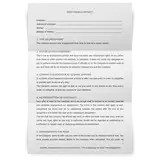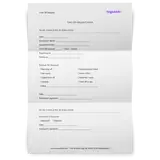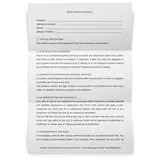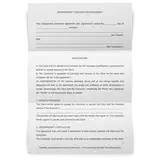Be sure to download this Cash Flow template to fill out as often as necessary, and check back for more financial templates.
What is a cash flow statement?
This cash flow statement template tracks the flow of cash in and out of your business. It is the most important statement for any business, alongside the income statement and balance sheet. Although it appears more complicated than the other two documents, this easy cash flow statement template is actually simple to follow and it will help you get your future financial statements in order.
Do I need a cash flow statement template?
This statement is a legal requirement for many businesses across the world. It is especially important for publicly traded companies and provides transparency of cash flow to both governments and shareholders.
It can also be compared to an income statement to discern any discrepancies in income. This can sometimes happen when losses are not yet reported as expenses in your financial statements. Bigger differences can come about from accounting errors or even fraud, both of which are important to report and fix.
Last but not least, stakeholders and investors can predict future cash flows based on this document.
Direct vs Indirect
A direct method cash flow statement template is rarely used. It records all movements of cash as separate flows.
This free cash flow statement template is an indirect method, which is the format used by most businesses. An indirect method statement records cash statements in operating activities as adjustments to the net income.
For example, if the starting amount is calculated before taxes, the cash flow must adjust its final result to account for the taxes that will be paid.
The three sections of a simple cash flow statement template
As a means of organization, the cash flow statement template is recorded in three categories:
Cash flow from operational activities
Cash from operating activities is for any activities that result in direct revenue or expenses, as well as anything that does not fit into the other categories. Cash inflows from operations are often sales to customers or clients, increases in accounts payable, and depreciation. Meanwhile, common sources of cash outflows are operating expenses, increases in accounts receivable, and purchase of inventory.
When analyzing the numbers here, you will see the basic breakdown of where money is being generated. Investors will study this section closely to see if a company is worth their time. Accounts receivable and payable are especially important to examine, as they can show issues with billing and collections.
Consider this as a company income statement with day to day expenses in cash or cash equivalents.
Cash flow from investing activities
Here, cash flow from non-current assets is recorded. Most often it involves purchases of equipment and land, but it can also include investment items such as stocks and bonds. Small companies might not have huge cash flow in this area at first.
The cash flow of this section can show the current growth of a company, as they will be investing funds into the purchase of new assets. At a glance, they can see if you have adequate cash flow and if there are any cash flow issues they should be afraid of. A decrease in cash flow is a surefire signal that you're not safe to invest in.
Cash flow from financing activities
Any money borrowed or repaid is recorded here. A company’s own equity and dividend payments also belong under financing activities.
This section is very important for large companies and their investors. Potential investors will want to see consistent repayment of any debt, sustainable injections of capital, and that dividends are paid. It is vital for a growing company to showcase its financial strategy through its cash flow in this section. This can include cash receipts and other documents for the statement of cash flow.
What else can I learn from this cash flow statement template?
Heavy cash flow doesn’t necessarily correlate to high income over a time period. For example, depreciation affects cash flow without being cash that is generated or spent. A company may appear to have losses one year due to many purchases of new equipment and facilities, then these purchases will cause an exponential increase in revenue the next year.
Another company could appear to be making income, but its cash flow statement will reveal that their business strategy is unsustainable in the long run.
While an income statement is still useful for analyzing a company, the cash flow statement can reveal larger patterns. This knowledge helps to predict the future of the company if they stay on their current path. For business owners, it is vital to analyze the cash flow statement for this reason. Mistakes and strategies capable of killing a business will often reveal themselves in the cash flow statement.
What do I need to fill out this business cash flow statement template?
It is necessary to have already completed an income statement and balance sheet before filling out the cash flow statement template. These numbers will help to determine the net income and other liabilities, assets, and capital. You will also need any other documents relevant to your cash flow, such as equity reports, legal documents, and investment records.
Things to consider in this statement of cash flow template
When recording cash values, it is important to separate positive inflow from the negative outflow. One easy way to do this is to record outflow in parentheses. For example, the generation of $300 from customers will be recorded normally, while the loss of $300 from expenses will be recorded as ($300).
Calculate net income
You can find your net income on your income statement. Indirect impacts, such as depreciation, will be accounted for in the adjustments section. It is crucial that you are able to see how these expenses affect your overall income, to analyze if there are any problems that will lower your revenue in the future. For example, too many bank loans or long-term debt is not a good look.
Factor in depreciation
Many assets will lose value over a period of time, such as office computers that break down or become outdated. When the depreciation value reaches zero, the asset is considered to be useless to the business. Calculating depreciation into operating activities helps to account for these expenses.
In an income tax report, depreciation is an expense that reduces taxable income. This lowers taxable income owed to the government. Although depreciation has an indirect impact on cash flow, this makes it a vital part of any cash flow statement template. It is negated by the original asset purpose, but nonetheless must be added back to the operational activities.
Pay attention to Accounts Receivable (AR)
Your AR is like a line of credit. If a customer or client pays for a product or service a set number of days after being billed, this is AR. It is owed money that must be paid back by customers. Rather than calculating the total amount owed to you, the AR in the cash flow statement template reports on changes to this amount.
A positive AR will show that customers have repaid you more than unpaid AR has accrued. A negative AR shows that much more customers owe you money than having paid you back. It is important for this number to be as high as possible, as unpaid AR is ultimately revenue that is not yet in your company funds.
If this amount is often negative, it shows that you need to make changes to your collections and billing policies.
How often should I complete this cash flow statement template?
A small company may only wish to complete this template annually or the legally required times per year. However, it is most beneficial to complete the template every few months, if not monthly.
This is because the statement will show revenue issues in a business that might not be reflected on an income statement. Detecting these cash flow problems in advance will help to prevent future losses in revenue through cash inflows.
![Cash Flow Statement Template [Free Download]](/static/image?src=https%3A%2F%2Fcdnblog.unrubble.com%2Fpayload-unrubble-images%2FCash-Flow-Statement-Template-600x600.png&width=512&height=512&fit=contain&position=center&quality=65&compressionLevel=9&loop=0&delay=100&crop=null&contentType=image%2Fwebp)




